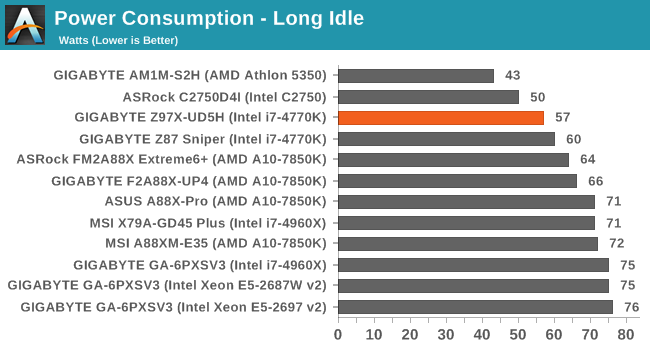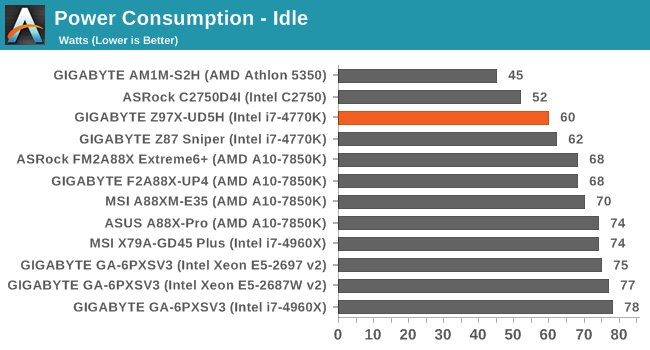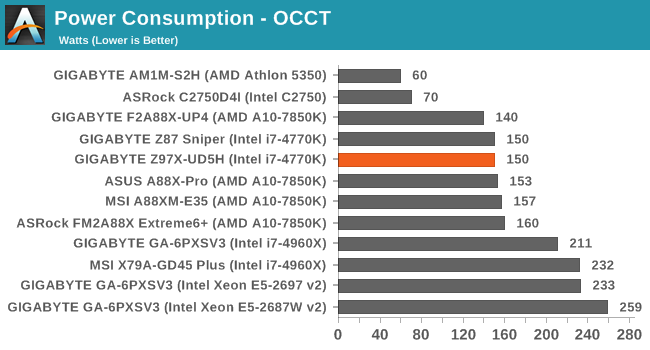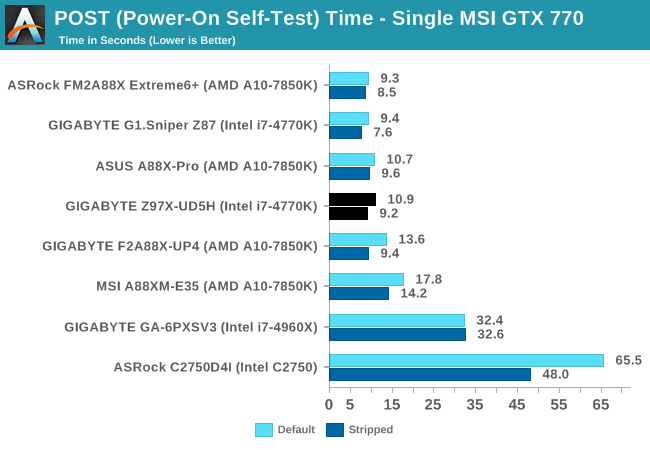GIGABYTE Z97X-UD5H Review: Choose Your Storage Option
by Ian Cutress on May 14, 2014 9:00 AM EST- Posted in
- Motherboards
- Intel
- Gigabyte
- Z97
Many thanks to...
We must thank the following companies for kindly providing hardware for our test bed:
Thank you to OCZ for providing us with PSUs and SSDs.
Thank you to G.Skill for providing us with memory kits.
Thank you to Corsair for providing us with a PSU, a H80i CLC and DRAM.
Thank you to ASUS for providing us with the AMD HD7970 GPUs and some IO Testing kit.
Thank you to MSI for providing us with the NVIDIA GTX 770 Lightning GPUs.
Thank you to Rosewill for providing us with the PSUs and RK-9100 keyboards.
Thank you to ASRock for providing us with the 802.11ac wireless router for testing.
Test Setup
| Test Setup | |
| Processor |
Intel Core i7-4770K ES 4 Cores, 8 Threads, 3.5 GHz (3.9 GHz Turbo) |
| Motherboards | GIGABYTE Z97X-UD5H |
| Cooling |
Corsair H80i Thermalright TRUE Copper |
| Power Supply |
OCZ 1250W Gold ZX Series Corsair AX1200i Platinum PSU |
| Memory | G.Skill RipjawsZ 4x4 GB DDR3-1600 9-11-9 Kit |
| Memory Settings | 1600 9-11-9-27 1T tRFC 240 |
| Video Cards |
MSI GTX 770 Lightning 2GB (1150/1202 Boost) ASUS HD7970 3GB (Reference) |
| Video Drivers |
Catalyst 13.12 NVIDIA Drivers 335.23 |
| Hard Drive | OCZ Vertex 3 256GB |
| Optical Drive | LG GH22NS50 |
| Case | Open Test Bed |
| Operating System | Windows 7 64-bit SP1 |
| USB 2/3 Testing | OCZ Vertex 3 240GB with SATA->USB Adaptor |
Power Consumption
Power consumption was tested on the system as a whole with a wall meter connected to the OCZ 1250W power supply, while in a single MSI GTX 770 Lightning GPU configuration. This power supply is Gold rated, and as I am in the UK on a 230-240 V supply, leads to ~75% efficiency > 50W, and 90%+ efficiency at 250W, which is suitable for both idle and multi-GPU loading. This method of power reading allows us to compare the power management of the UEFI and the board to supply components with power under load, and includes typical PSU losses due to efficiency. These are the real world values that consumers may expect from a typical system (minus the monitor) using this motherboard.
While this method for power measurement may not be ideal, and you feel these numbers are not representative due to the high wattage power supply being used (we use the same PSU to remain consistent over a series of reviews, and the fact that some boards on our test bed get tested with three or four high powered GPUs), the important point to take away is the relationship between the numbers. These boards are all under the same conditions, and thus the differences between them should be easy to spot.



The UD5H beats the older Z87 Sniper for power consumption, and out of the Z97 boards we've tested so far it comes out better than most.
Windows 7 POST Time
Different motherboards have different POST sequences before an operating system is initialized. A lot of this is dependent on the board itself, and POST boot time is determined by the controllers on board (and the sequence of how those extras are organized). As part of our testing, we are now going to look at the POST Boot Time - this is the time from pressing the ON button on the computer to when Windows 7 starts loading. (We discount Windows loading as it is highly variable given Windows specific features.) These results are subject to human error, so please allow +/- 1 second in these results.

With Windows 8 having more market share, the impetus to improve POST times for Windows 7 systems might not be at the top of a manufacturers list. However the Z97X-UD5H puts in a good show under 11 seconds by default, and almost 9 seconds when stripped.










53 Comments
View All Comments
silenceisgolden - Wednesday, May 14, 2014 - link
So I think I might be a few PCIe lanes off, but would it be feasible to get rid of the PCI, one LAN slot, the D-SUB (because why is that still useful with DVI available), the PCI Express/M.2/SATA6 switch but keep the M.2? Then either add in another USB3, SATA6, or if possible in the future, another M.2 stacked on top of the first. I would think this would be the best combination of connectivity that the mainstream to enthusiast range of PC builders are looking for, and would stop the continuation of older standards or these choices that people have to make that might not be obvious when they are plugging stuff in to the motherboard.Chil - Wednesday, May 14, 2014 - link
The BIOS screenshots of both HD and Classic Mode show a BCLK of 99.79 MHz. Isn't the standard 100.0? Can anyone comment on if this is a bug or expected behavior and how it affects performance?The_Assimilator - Wednesday, May 14, 2014 - link
It's possible that AnandTech had Spread Spectrum enabled, but I have that option disabled on my Asrock Z77 Extreme6, and its BCLK fluctuates between 99.97MHz and 99.99MHz at boot (I have never seen it do a flat 100.00MHz).Chil - Thursday, May 15, 2014 - link
99.97 is right around what I expect, but 99.79 (0.21 off the mark) is a different story. I did a big of searching and this appears to affect Gigabyte's entire "ultra durable" lineup.maecenas - Wednesday, May 14, 2014 - link
Given that you've run a few articles explaining how modern games are GPU dependent, and very rarely is the CPU the bottleneck in single-card applications, I'm really not clear on how a motherboard is going to have a significant impact on gaming performance, holding the GPU and CPU constant.extide - Wednesday, May 14, 2014 - link
It doesnt. The only thing is really the PCIe lane allocation, and if it possibly uses a PLX chip. Also, the feature set may be different, but the motherboard doesn't really affect performance.Ian Cutress - Wednesday, May 14, 2014 - link
PCIe lane allocation is important if you are not limited by the CPU first (see our Haswell refresh). There are some weird and wonderful chipset lane allocations when you move into the world of the PLX chip, or some server boards miss out lanes altogether. If/when I move to 4K gaming benchmarks (2015? depends on 24"/27" 60Hz monitor pricing) we might see a greater effect there.The_Assimilator - Wednesday, May 14, 2014 - link
Flex IO is a step in the right direction from Intel. That said, it could be so much more; in fact it would make the most sense if ALL Flex IO ports were switchable between PCIe/USB3/SATA3. That would allow motherboard manufacturers to provide e.g. native 10 SATA ports without having to purchase and integrate additional standalone SATA controllers, which are slower and add to the BOM. I'd be pretty happy with a motherboard that did a 2/8/8 split for PCIe/USB3/SATA3.Additionally, the 14 USB 2.0 ports are ridiculous; I don't think I've ever seen a motherboard that provides that many. Intel should aggregate 10 of those ports into an additional Flex IO port, which would leave 4 USB 2.0 ports. Anyone who needs more than a minimum of 8 USB ports (4 USB2 + minimum of 4 USB3) can buy a USB hub.
DanNeely - Wednesday, May 14, 2014 - link
8 back panel ports and 3 mobo headers for 6 more was a relatively common config a few years ago. I think I've seen 6 back panel and 4 headers a few times too. 3 mobo headers covers a case with 4 front panel ports and a card reader in a drive bay. Other than being mostly USB3 this board has the same 8 back panel and 3 header configuration.I'm not sure why Intel didn't cut the number of 2.0 ports down when they added USB3 to the chipset, but IIRC a USB2 controller is tiny compared to a USB3/PCIe lane/Sata6 controller. It's entirely possible that it came down to the 2.0 controllers being a small enough chunk of the chip that it wasn't worth fiddling with them because it couldn't affect enough space to matter for anything else.
repoman27 - Wednesday, May 14, 2014 - link
Well A: the USB 2.0 controllers, hubs, ports were already there, so it's easier to just let them be, and B: every USB 3.0 port uses a USB 2.0 port as well. Thus you really have a maximum of 14 USB ports total, up to 6 of which can be USB 3.0.